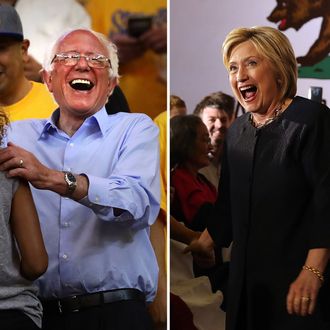
As recently as late April, it looked like California would have the rare occasion to play a significant role in a presidential-nominating contest — the Republican contest, that is. The GOP’s “winner take most” rules for the Golden State made it potentially the clincher for that irresistible force, Donald Trump, or the immovable object that made a contested convention likely. With Hillary Clinton drifting towards a majority of pledged delegates, it wasn’t so clear California would matter that much to Democrats.
But now, on the eve of the June 7 primary, the Republican fight is long over, and although Clinton is still almost certain to win the nomination, Bernie Sanders has made California his closing argument for claiming the future of the Democratic Party (if not for his 74-year-old self, then for progressive successors) and some influence over its current platform and general-election campaign.
That’s more than a bit of a surprise. In a nomination fight where nonwhite voters have been Clinton’s ace-in-the-hole, you’d figure this majority-minority state — where she handily defeated Barack Obama in 2008 — would be a stronghold. Moreover, California’s size and many expensive media markets make it — for all its reputation for political eccentricity — an interest-group-dominated state, where labor still walks tall and primary turnout is usually very low. And indeed, Clinton has led every single public poll taken in the state, 19 in all.
But it’s been getting closer, with four late, credible polls (including the revered Field Poll) showing Clinton’s lead among likely voters down to two points. A big spring spike in new Democratic voter registrations has made observers wonder if the Bern is responsible, and if turnout may not be as low as expected.
Most astonishingly, if Field and PPIC surveys are accurate, Clinton’s regular advantage among nonwhite voters has vanished in California. Field has her leading among Latinos, far and away the state’s leading minority group, by a spare 46/42 margin. Her lead among African-Americans — the third largest minority group in the state — is a robust but not overwhelming 56/37. And she’s losing to Sanders among Asian-Americans — an estimated 11 percent of the primary electorate — by 13 points.
At the same time, the two candidates are tied among white voters — normally a Sanders constituency.
The explanation? It’s all about age: Sanders’s 75/15 (according to Field) lead among under-30 voters and Clinton’s 56/28 lead among over-65 voters have overwhelmed the usual racial gaps in their bases of support.
And so, the precise outcome of this close primary is hard to predict, and could depend on some unusual dynamics. California is a heavy voting-by-mail state; in 2014, 69 percent of the primary ballots were cast by mail, and Field showed Clinton with a nine-point lead among those who had voted by mail early. Registered independents are being allowed to vote in the Democratic (but not the Republican) primary this year, but they have to know to ask for a Democratic ballot (either by mail or when they appear at the polls on June 7) or they will be presented with a blank presidential field. Since independents are, as usual, an important Sanders constituency, his campaign’s competence in educating voters is crucial. And to an extent Californians haven’t seen in a generation, Clinton and Sanders have spent a lot of time barnstorming the state.
Regionally, Sanders will try to run up the score in the San Francisco area and the Central Coast, while Clinton is expected to win Los Angeles County and the Central Valley. Most assessments of the campaign have ceded late momentum and overall “enthusiasm” to Sanders, but Clinton has won some key endorsements, including that of both leading Democratic Senate candidates and Gov. Jerry Brown.
But the thing to remember is this: A narrow Sanders win will be mainly of psychological value. Of the 475 pledged delegates awarded by California, 158 are split proportionately according to the statewide vote, and the other 317 are split proportionately at the congressional-district level, with the state’s 53 districts receiving somewhere between five and nine delegates, depending on past Democratic performance. A big net-delegate harvest for Sanders will require a big popular-vote victory, and the polls just don’t show that as remotely likely — barring some really strange pro-Bernie turnout dynamics. So the current din of hype over who will “win” California is largely a shuck. Who will win California? Who cares?
Still, if moral victories are the only ones available, winning the biggest state — and the one with an intermittently justified reputation as a political and cultural bellwether — is as good as it gets. If Sanders indeed runs even with Clinton among nonwhite voters, he can claim that he — and his kind of politics — eventually transcended the bleached wine-track limitations it was initially assigned.
If Clinton hangs on to win California, however, voices will quickly be raised demanding that Sanders get out of the race post-haste. At some point, the great future-oriented potential of the “movement” Bernie helped create has to be actualized or pushed off until after Clinton’s or Trump’s first term as president. A California win for Sanders would delay that realization just a bit longer.
And so the widely shared media perspective that Sanders has nothing to lose and everything to gain in California is not quite right. It could be the end of his remarkable campaign if he fails to finish first. If he does edge Clinton, the show may go on for another month or so before its inevitable closing.
An earlier version of this post stated that Bernie Sanders is 75. He is 74.






























